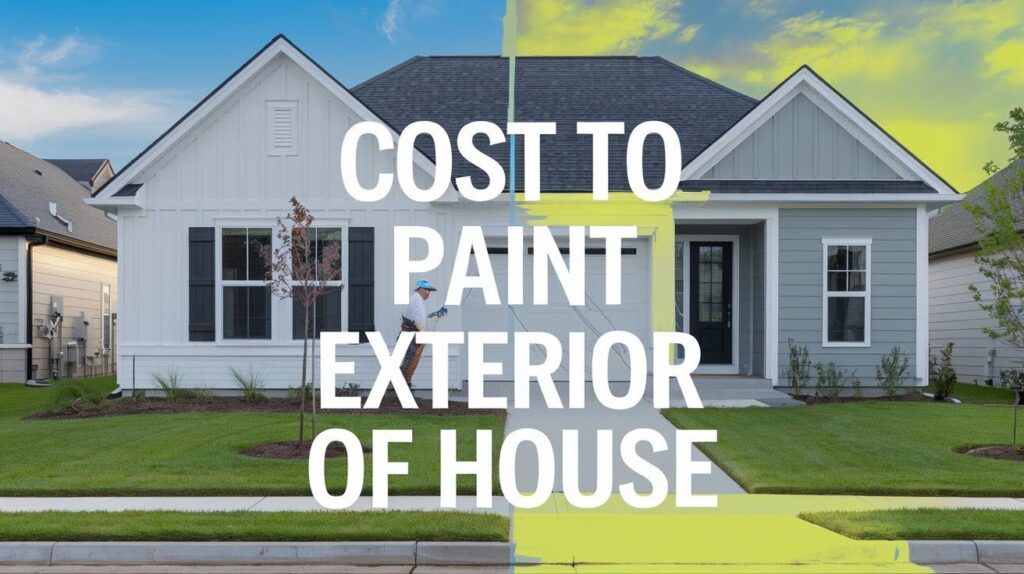Planning to paint your house exterior? You need real numbers, not guesswork.
I’ve spent years painting homes and running cost estimates. I know exactly what drives prices up and down.
In this guide, I’ll show you actual costs broken down by house size, regional differences, and material choices. You’ll discover ways to save money without cutting corners. I’ll compare DIY versus hiring professionals with honest pros and cons.
Here’s what you’ll learn, average costs for different house sizes Factors that increase or decrease your bill, labor versus material cost breakdowns, regional price differences across, America Money-saving strategies that actually work
My goal? Help you budget correctly and avoid surprises. No sales pitch. Just straight facts from someone who’s been there.
Average Cost to Paint the Exterior of a House
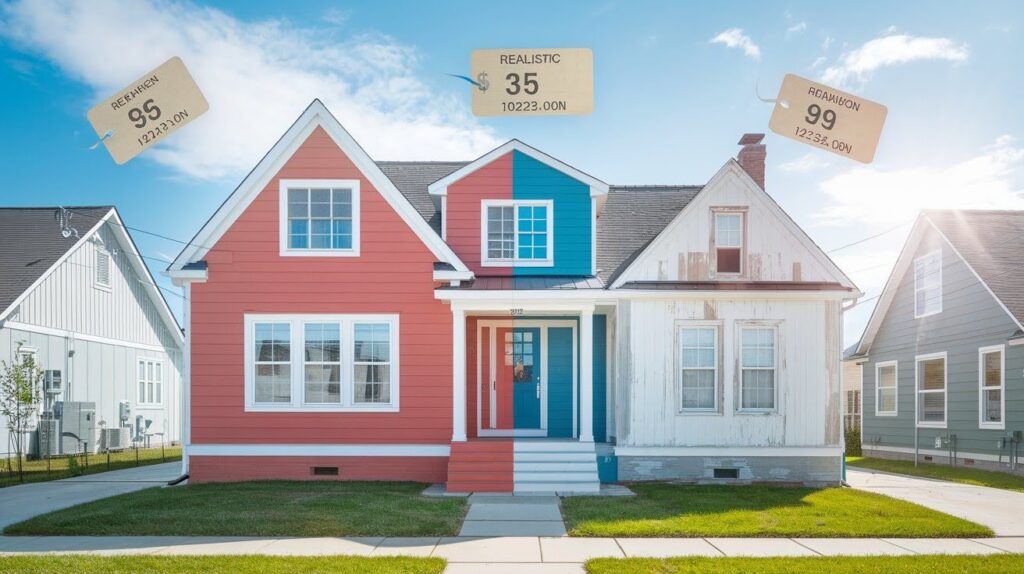
Here’s what you can expect to pay:
- Small house (1,000-1,500 sq ft): $2,500 – $4,500
- Medium house (1,500-2,500 sq ft): $4,500 – $7,500
- Large house (2,500-3,500 sq ft): $7,500 – $12,000
- Very large house (3,500+ sq ft): $12,000 – $20,000+
These are just averages though. Your actual cost depends on several key factors that most people don’t think about.
Factors That Influence the Cost to Paint Exterior of a House
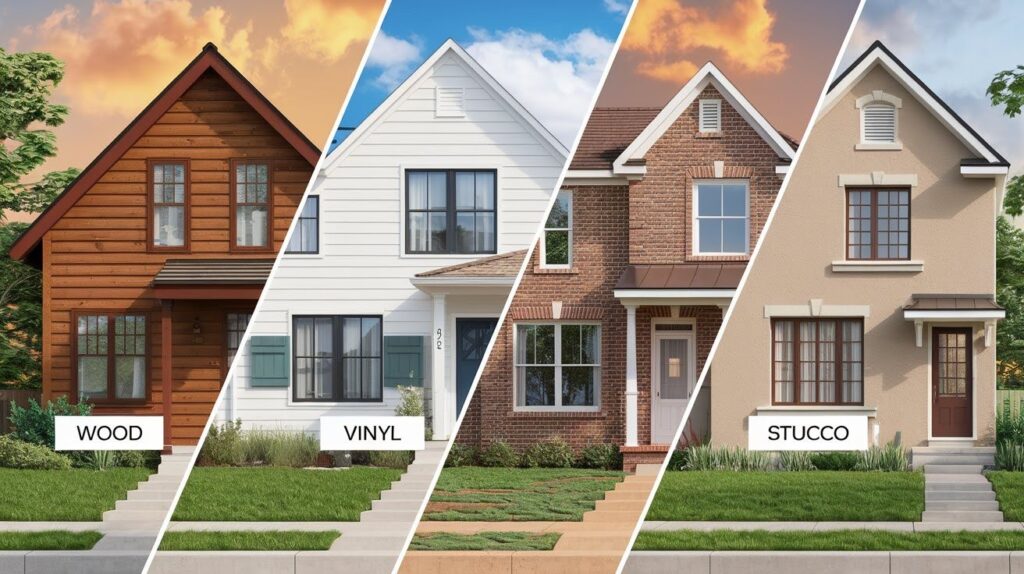
House Size and Height
This one’s obvious. A bigger house equals a bigger bill.
But height matters more than square footage. A two-story house costs 40-50% more than a single-story of the same size. Why? Ladders, scaffolding, and safety equipment add serious labor costs.
Current Condition of Your Siding
Fresh, clean siding? You’re golden.
Peeling paint, rotted wood, or damaged areas? Your costs just doubled.
I always tell my clients: prep work is 60% of the job. If your house needs extensive scraping, sanding, or repairs, expect to pay $1-3 per square foot just for prep.
Type of Siding Material
Different materials demand different approaches:
- Wood: Most expensive to paint ($2-4/sq ft)
- Vinyl: Cheapest option ($1-2/sq ft)
- Brick: Requires special primers ($2-3/sq ft)
- Stucco: Texture adds complexity ($2-3.50/sq ft)
Paint Quality
Here’s where many homeowners make costly mistakes.
Cheap paint = cheap results = repainting sooner
I recommend mid to high-grade exterior paints. They cost 20-30% more upfront but last twice as long. Never skimp on primer. It’s the foundation of a lasting paint job.
Cost Breakdown: Labor vs. Materials
Understanding this split helps you make smarter decisions.
| Cost Type | Percentage of Total | Details |
| Labor | 60-70% | Prep work, painting, cleanup |
| Materials | 30-40% | Paint, primer, supplies |
Labor Costs
Professional painters charge $25-50 per hour. Most quote by square foot, $1.50-$4.00 per square foot for labor alone.
Quality painters cost more. But they also finish faster and deliver better results.
Red flag: Quotes significantly below market rate. Cheap labor often means corner-cutting.
Material Costs
| Material | Cost Range | Coverage/Notes |
| Paint | $30-80 per gallon | Covers 350-400 sq ft per coat |
| Primer | $25-50 per gallon | Essential for proper adhesion |
| Brushes and rollers | $50-100 | Quality tools make a difference |
| Drop cloths and tape | $30-60 | Protection for landscaping |
| Ladder rental | $100-300 | Safety equipment for DIY |
One gallon covers about 350-400 square feet with one coat. Most exteriors need two coats.
DIY vs. Hiring a Professional
I get this question constantly. Should you paint your house yourself?
| Factor | DIY | Professional |
| Cost | Save 60-70% on labor | Higher upfront cost |
| Time | 3-4x longer | Faster completion |
| Quality Control | Complete control | Experienced results |
| Risk | Injury risk on ladders | Insured and trained |
| Warranty | No warranty if issues | Work guaranteed |
| Learning Curve | Mistakes happen | Proven techniques |
When to Choose DIY:
| Condition | Yes/No |
| Single-story house | Yes |
| Have painting experience | Yes |
| Own or can borrow equipment | Yes |
| Have 2-3 weeks available | Yes |
| Comfortable on ladders | Yes |
When to Hire Professionals:
| Situation | Recommendation |
| Two-story or higher homes | Hire pros |
| Extensive prep work needed | Hire pros |
| Tight timeline requirements | Hire pros |
| Want premium finish | Hire pros |
| No painting experience | Hire pros |
Reality check: DIY saves money only if you value your time at less than $15-20 per hour.
Regional Cost Variations in the U.S.
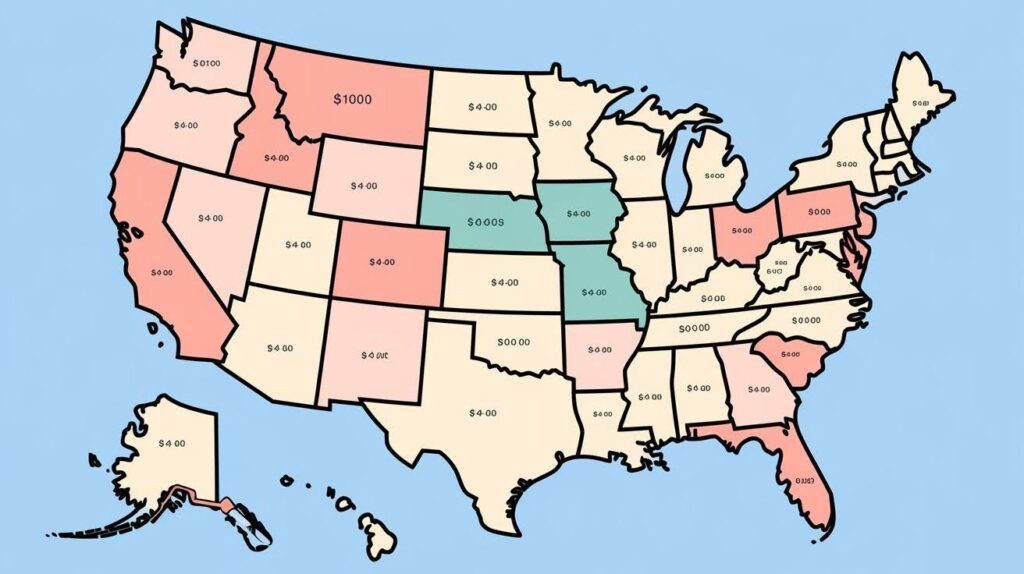
Location impacts your final bill.
Highest Cost Regions:
- Northeast: 15-25% above national average
- West Coast: 20-30% above national average
- Major metros: 10-40% more
Lowest Cost Regions:
- Southeast: 10-20% below national average
- Midwest: 5-15% below national average
- Rural areas: 15-25% below national average
Why the Difference?
Labor costs. Materials stay fairly consistent nationwide. But skilled painters command higher wages in expensive cities.
Get quotes from at least three local contractors. Prices can vary 50% or more between companies.
How Often Should You Repaint Your House?
This affects your long-term budget planning.
Typical timeframes:
- Wood siding: Every 5-7 years
- Vinyl siding: Every 8-10 years
- Brick: Every 10-15 years
- Stucco: Every 10-15 years
Climate matters. Hot, sunny climates fade paint faster. Coastal areas deal with salt damage. Northern climates face freeze-thaw cycles.
Quality paint lasts longer. Premium paints with UV protection can extend your timeline by 2-3 years.
Money-Saving Tips Without Sacrificing Quality
I’ve learned these tricks from 15 years in the business.
- Paint in fall or late winter when contractors offer 10-20% discounts during slow seasons
- Do your own power washing and minor scraping to save $500-1,500 on prep work
- Choose light colors that last longer and fade slower than dark colors
- Buy high-quality paint yourself to avoid 20-50% contractor markups
- Bundle multiple projects like trim work or repairs for package discounts
Environmental & Long-Lasting Paint Options
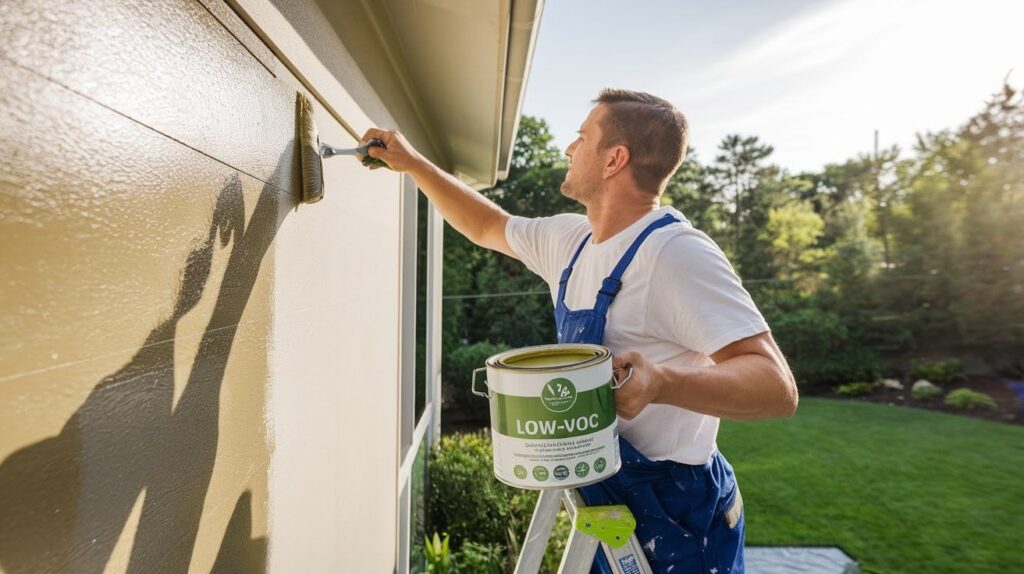
Going green doesn’t have to cost more.
Eco-Friendly Options
Low-VOC paints cost about the same as traditional paints now. They’re safer for your family and the environment. Water-based paints clean up easier and dry faster than oil-based options.
Long-Lasting Technologies
Ceramic paints cost 30-50% more upfront but can last 15-20 years. They’re worth it for hot climates. Self-priming paints eliminate primer steps on some surfaces. This saves time and money.
Return on Investment
Quality exterior paint jobs return 60-80% of their cost in home value. A $8,000 paint job adds $5,000-6,500 to your home’s value.
Conclusion
You now have everything I wish I’d known before my first painting project. These real costs will help you budget correctly.
I’ve given you honest numbers from years in the business. No hidden surprises or sales tricks.
Your next move is simple. Get three detailed quotes from licensed contractors. Ask each one about prep work, paint brands, timeline, and warranty coverage. Compare their processes, not just prices.
Remember this: the cheapest quote often costs more in the long run. Quality contractors explain their work and use proven materials.
Your house is your biggest investment. It deserves protection that lasts. Start calling contractors today. Your fresh, beautiful exterior is closer than you think.
Frequently Asked Questions
Does house color affect painting costs?
Dark colors cost 10-15% more than light colors. They require special primers and often need extra coats to achieve even coverage.
Can I paint over old paint without scraping?
Only if the existing paint is in good condition with no peeling or flaking. Most houses need at least some scraping and sanding for proper adhesion.
What’s the best time of year to paint my house exterior?
Late fall through early spring offers the best contractor rates. Avoid summer peak season when prices jump 20-30% higher due to demand.
How long should I wait between exterior paint jobs?
Quality paint jobs last 7-10 years in most climates. Houses in harsh sun, coastal areas, or extreme weather may need repainting every 5-6 years.
Is it worth paying extra for premium paint brands?
Yes, premium paints cost 30% more but last twice as long. They also provide better coverage, meaning you’ll use less paint overall.

